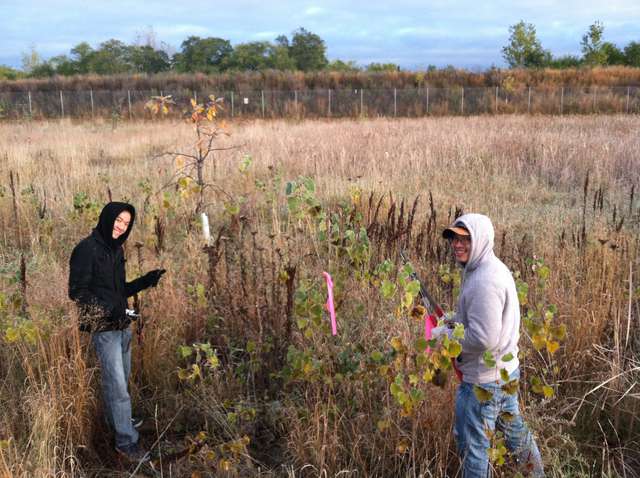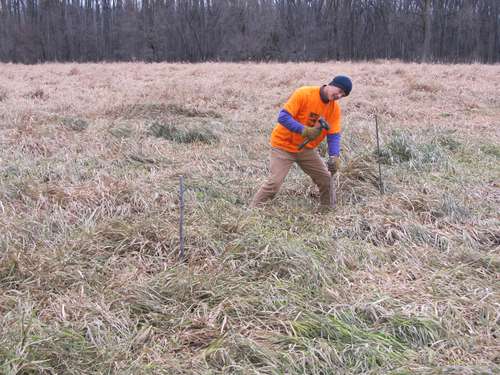Restoring a floodplain forest, one branch at a time

Students from Inver Hills College cut small cottonwood trees, which were invading a prairie. The cut stems, called livestakes, were installed at a floodplain forest at Rock Island Swing Bridge Park.
Photo: Tanya Smutka
The stately cottonwood tree (Populus deltoides) is the largest tree in Minnesota, reaching heights of 120 ft and diameters of 5 ft, and is also the fastest growing tree in North America*. It requires full sun and is a pioneer species of floodplain forests, its preferred habitat. It is well-adapted to the floodplain environment, capable of easily surviving extended periods of intensive flooding. Its spreading roots are important riverbank anchors, while the expansive branches and deeply furrowed bark provide habitat for many creatures.
A favored tree for nesting bald eagles, cottonwoods also serve dozens of other birds, mammals, and insect species, which find refuge in its canopy, eat the buds and fruit, nest in the branches, live in hollow branches or trunks, forage in the deep bark furrows, use the downy seed fluff, and carry out various stages of their life cycles in its immense canopy.
But cottonwood trees are no longer establishing the way they used to along the Mississippi. Female trees can produce up over 40 million seeds per year, so seed production is certainly not lacking. What is lacking is suitable germination and growing conditions. The seeds require bare soil and the trees require full sun in all stages of growth. These conditions are becoming increasingly less common due in part to the spread of non-native reed canary grass. This grass proliferates in wetlands and riparian areas, where it forms very dense monotypic stands, leaving no bare soil for cottonwood seeds.
Altered flooding cycles have also played a role. Historically, spring floodwaters would typically recede in April and May, leaving large expanses of exposed soils along the rivers just in time for the cottonwood seed rain in late May. Flooding is now happening more frequently, for longer duration, and at atypical times of the year, making cottonwood seedling survival much less likely. Today, much of the floodplain is dominated by silver maple, which can tolerate shade much more than cottonwoods. There are still a few large cottonwoods persisting, but with no seedlings to replace them, this important species may be doomed to disappearing from the Upper Mississippi floodplain.

Livestakes are pounded about a foot into the ground. These were taller than normal to facilitate survival in the tall reed canary grassland at Gores Wildlife Management Area (WMA) in Hastings.
Photo: Karen Schik/FMR
Several state and federal agencies have become concerned about the lack of cottonwood regeneration throughout the entire Upper Mississippi River System (UMRS). The Army Corp of Engineers (ACOE) and the U.S. Geological Survey (USGS) have been studying the issue and experimenting with cottonwood establishment methods. They have had good results with a process called livestaking, whereby small branches cut from existing trees during winter dormancy are inserted directly into the ground. Only a few woody species have the ability to grow roots from a branch, most notably willows, cottonwood and dogwood. In fact, the rooting hormone that growers purchase to help induce root growth in cuttings is typically derived from willows. Being cousins of willows in the Salicaceae family, cottonwoods are imbued with these hormones too.
In 2013, FMR initiated trial projects to establish cottonwood trees from livestakes at Gores Pool Wildlife Management Area (WMA) in Hastings and at the Rock Island Swing Bridge Park in Inver Grove Heights. At the latter site, about 30 students from Inver Hills Community College spent two mornings cutting cottonwood livestakes from an upland location where they were invading a prairie, and installing them in openings in a floodplain forest at the park. The ACOE and USGS have found that as long as the floodwaters do not cover the livestakes for more than a week after they have broken dormancy, survival rates are very high. At Gores WMA, a small number of livestakes were planted into a reed canary-dominated grassland to see how well they can compete against the very aggressive grass. The stakes were taller than usual, about 4 to 5 feet, to keep them above the shade of the grass. If survival is good, we will likely be installing many more cottonwood livestakes in the future.
*Smith, W. R. 2008. Trees and shrubs of Minnesota. University of Minnesota Press, Minneapolis, MN.